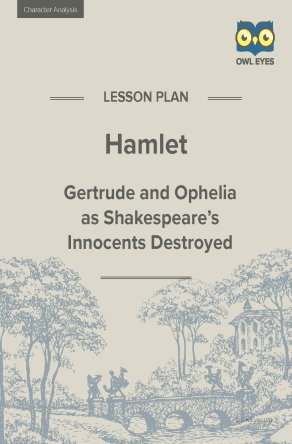Hamlet Character Analysis Lesson Plan
- 22 pages
- Subject: Character Analysis, Themes, Lesson Plans and Educational Resources
- Common Core Standards: RL.11-12.1, RL.11-12.2, RL.11-12.3
- Grade Levels: 11, 12, Undergraduate
Additional Hamlet Resources
Product Description
Gertrude and Ophelia as Shakespeare’s Innocents Destroyed
This lesson plan focuses Gertrude’s and Ophelia’s roles as innocent, tragic victims in Hamlet who succumb to the demands of their society and the deadly forces in Claudius’s court. Students will contrast their positions in the court, describe their relationships with Hamlet, Claudius, and Polonius, and analyze examples of Gertrude’s and Ophelia’s actions that are determined by the gender roles society expects them to conform to in their relationships with men. In studying Gertrude’s and Ophelia’s characters, students will be better able to describe how gender roles affect these women, how political intrigue destroys them, and how their tragic lives underscore a major theme in the drama.
Skills: Among those innocents drawn into the deadly political intrigue of Claudius’s court, none suffer more than Gertrude and Ophelia, whose tragic lives emphasize a major theme in Hamlet.
Learning Objectives: By the end of this lesson, students will be able to
- describe Gertrude’s and Ophelia’s characters, contrast their positions in Claudius’s court, and explain how their gender dictates their thinking and behavior.
- analyze how Gertrude and Ophelia feel about Hamlet, Claudius, and Polonius.
- identify examples of Gertrude’s and Ophelia’s being innocent of the political intrigue in Claudius’s court and being unwittingly drawn into it.
- explain why Gertrude and Ophelia can be viewed as tragic figures and how their personal tragedies support a major theme in the play.
About This Document
Owl Eyes lesson plans have been developed to meet the demanding needs of today’s educational environment and bridge the gap between online learning and in-class instruction. The main components of each plan include the following:
- An introduction to the text
- A step-by-step guide to lesson procedure
- Previous and following lesson synopses for preparation and extension ideas
- A collection of handouts and worksheets complete with answer keys
Each of these comprehensive, 60-minute plans focus on promoting meaningful interaction, analytical skills, and student-centered activities, drawing from the Common Core Standards for English Language Arts and the expertise of classroom teachers.
Introduction to the Lesson
Critical analysis and literary interpretations of Hamlet typically focus on Shakespeare’s protagonist, the tormented Prince Hamlet who seeks to avenge the murder of his father, the king of Denmark. Also subject to much analysis and interpretation is Hamlet’s antagonist and uncle, the vile Claudius, who commits regicide to usurp the throne and marry Gertrude, his brother’s widow, to make her his queen and satisfy his lust for her.
The deadly enmity between Hamlet and Claudius and their plotting to destroy each other dominate the play, driving the plot and drawing other characters into their political intrigues. Some members of Claudius’s court willingly assist him in his schemes; others are unwittingly ensnared in various plots. None of them, however, escape the consequences of Hamlet’s and Claudius’s mutual hatred and deceit. Ultimately, they all suffer, and many of them die.
Among those who are unwittingly drawn into the political intrigue in Claudius’s court are Gertrude and Ophelia, the only two women in the play. Quite different in age and social rank, they are similar in ways that are not immediately obvious but become evident as the plot unfolds.
Primarily, their similarities are rooted in their gender; as women, regardless of their positions in Claudius’s court, they are essentially powerless to think or act independently and publicly; instead, they fulfill the roles society demands of them—being subservient, loyal, and loving to the men whose actions determine the course of their lives. Ironically, Ophelia’s one act of independence is to take her own life, but her suicide is the result of melancholy rather than rebellion.
As Claudius’s court disintegrates into violence and bloodshed, Gertrude and Ophelia remain unaware of the secrets coursing through it. As a result, they become innocent, tragic victims destroyed by the malignant forces unleashed at court by the men they love.
Worksheet Excerpt: Analyzing Ophelia
-
In act I, scene iii, how does Ophelia demonstrate her subservient role as a woman, as Polonius’s daughter, instead of acting on her own judgment?
-
In act II, scene i, how does Ophelia demonstrate her dependence on Polonius and her obedience to him?
-
In act II, scene ii, Polonius and Claudius agree on a scheme to arrange a meeting between Hamlet and Ophelia and spy on them to observe Hamlet’s behavior. When they execute their plan in act III, scene i, how does Ophelia once again demonstrate her loyalty and obedience to Polonius, even though it requires her to deceive Hamlet, whom she loves?
-
Explain how Ophelia is unwittingly drawn into Polonius’s scheme regarding Claudius that is described in act II, scene i and into Hamlet’s continuing scheme to fool the court, as illustrated in act III, scene i.
-
Describe Ophelia’s mental and emotional state in act IV, scene v. What would account for it, considering her relationship with Hamlet and Polonius?
-
Ophelia’s death is announced in act IV, scene vii. Describe how she dies.
-
What details in act V, scene i suggest Ophelia committed suicide?
-
Sum it up: Explain how Ophelia can be interpreted as a tragic figure in the play.







